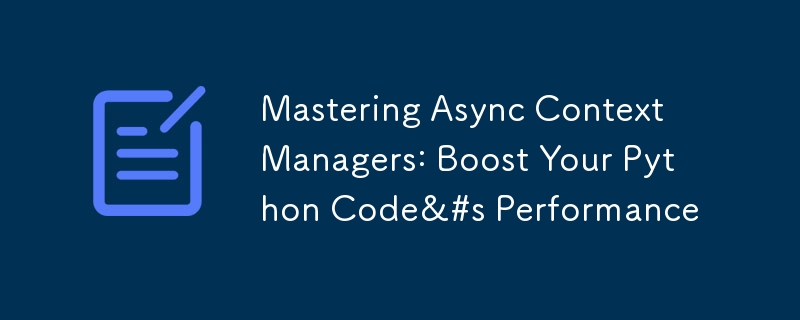
中的异步上下文管理器是处理并发应用程序中资源的游戏规则改变者。它们就像常规的上下文管理器,但有一点不同 – 它们可以与异步代码无缝协作。
让我们从基础开始。要创建异步上下文管理器,我们需要实现两个特殊方法:__aenter__ 和 __aexit__。这些是我们在常规上下文管理器中使用的 __enter__ 和 __exit__ 的异步版本。
这是一个简单的例子:
class asyncresource: async def __aenter__(self): print("acquiring resource") await asyncio.sleep(1) # simulating async acquisition return self async def __aexit__(self, exc_type, exc_value, traceback): print("releasing resource") await asyncio.sleep(1) # simulating async release async def main(): async with asyncresource() as resource: print("using resource") asyncio.run(main())
在此示例中,我们模拟资源的异步获取和释放。 async with 语句负责在正确的时间调用 __aenter__ 和 __aexit__。
现在,我们来谈谈异步上下文管理器如此有用。它们非常适合以非阻塞方式管理需要异步操作的资源,例如数据库连接、网络套接字或文件处理程序。
立即学习“”;
以数据库连接为例。我们可以创建一个管理连接池的异步上下文管理器:
import asyncpg class databasepool: def __init__(self, dsn): self.dsn = dsn self.pool = none async def __aenter__(self): self.pool = await asyncpg.create_pool(self.dsn) return self.pool async def __aexit__(self, exc_type, exc_value, traceback): await self.pool.close() async def main(): async with databasepool('postgresql://user:password@localhost/db') as pool: async with pool.acquire() as conn: result = await conn.fetch('select * from users') print(result) asyncio.run(main())
此设置可确保我们有效地管理数据库连接。池在我们进入上下文时创建,并在我们退出时正确关闭。
异步上下文管理器中的错误处理与常规错误处理类似。如果上下文中发生错误,则 __aexit__ 方法会接收异常信息。我们可以处理这些错误或让它们传播:
class errorhandlingresource: async def __aenter__(self): return self async def __aexit__(self, exc_type, exc_value, traceback): if exc_type is valueerror: print("caught valueerror, suppressing") return true # suppress the exception return false # let other exceptions propagate async def main(): async with errorhandlingresource(): raise valueerror("oops!") print("this will be printed") async with errorhandlingresource(): raise runtimeerror("unhandled!") print("this won't be printed") asyncio.run(main())
在此示例中,我们抑制 valueerror 但允许其他异常传播。
异步上下文管理器也非常适合实现分布式锁。这是一个使用 的简单示例:
import aioredis class distributedlock: def __init__(self, redis, lock_name, expire=10): self.redis = redis self.lock_name = lock_name self.expire = expire async def __aenter__(self): while true: locked = await self.redis.set(self.lock_name, "1", expire=self.expire, nx=true) if locked: return self await asyncio.sleep(0.1) async def __aexit__(self, exc_type, exc_value, traceback): await self.redis.delete(self.lock_name) async def main(): redis = await aioredis.create_redis_pool('redis://localhost') async with distributedlock(redis, "my_lock"): print("critical section") await redis.close() asyncio.run(main())
此锁确保一次只有一个进程可以执行关键部分,即使跨多台机器也是如此。
我们还可以将异步上下文管理器用于事务范围:
class asynctransaction: def __init__(self, conn): self.conn = conn async def __aenter__(self): await self.conn.execute('begin') return self async def __aexit__(self, exc_type, exc_value, traceback): if exc_type is none: await self.conn.execute('commit') else: await self.conn.execute('rollback') async def transfer_funds(from_account, to_account, amount): async with asynctransaction(conn): await conn.execute('update accounts set balance = balance - $1 where id = $2', amount, from_account) await conn.execute('update accounts set balance = balance + $1 where id = $2', amount, to_account)
此设置可确保我们的数据库事务始终正确提交或回滚,即使面对异常也是如此。
异步上下文管理器可以与其他异步原语结合使用,以获得更强大的模式。例如,我们可以将它们与 asyncio.gather 一起使用来进行并行资源管理:
async def process_data(data): async with ResourceManager() as rm: results = await asyncio.gather( rm.process(data[0]), rm.process(data[1]), rm.process(data[2]) ) return results
这使我们能够并行处理多个数据,同时仍然确保适当的资源管理。
总之,异步上下文管理器是管理异步 python 代码中资源的强大工具。它们提供了一种干净、直观的方式来处理异步设置和拆卸、错误处理和资源清理。通过掌握异步上下文管理器,您将能够构建强大的、可扩展的 python 应用程序,这些应用程序可以轻松处理复杂的并发工作流程。
我们的创作
一定要看看我们的创作:
投资者中心 | 智能生活 | 时代与回响 | 令人费解的谜团 | 印度教 | 精英开发 | js学校
我们在媒体上
科技考拉洞察 | 时代与回响世界 | 投资者中央媒体 | 令人费解的谜团 | 科学与时代媒介 | 现代印度教
以上就是Mastering Async Context Managers: Boost Your Python Code&#s Performance的详细内容,更多请关注php中文网其它相关文章!
 微信扫一扫打赏
微信扫一扫打赏
 支付宝扫一扫打赏
支付宝扫一扫打赏

